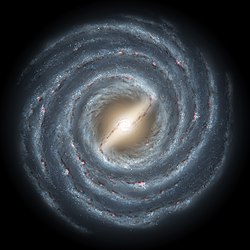Hydrus-I-Zwerggalaxie
| Galaxie Hydrus-I-Zwerggalaxie | |
|---|---|
 | |
| AladinLite | |
| Sternbild | Kleine Wasserschlange |
| Position Äquinoktium: J2000.0, Epoche: J2000.0 | |
| Rektaszension | 2h 29m 33,4s |
| Deklination | −79° 18′ 32,0″ |
| Erscheinungsbild | |
| Morphologischer Typ | dSph |
| Helligkeit (visuell) | (12,49 ± 0,08) mag |
| Physikalische Daten | |
| Zugehörigkeit | Lokale Gruppe |
| Entfernung | (90.000 ± 1.600) Lj / (27.600 ± 500) pc |
| Absolute Helligkeit | (−4,71 ± 0,08) mag |
| Metallizität [Fe/H] | −2,52 ± 0,09 |
| Geschichte | |
| Entdeckung | Koposov et al. |
| Entdeckungsdatum | 2018 |
| Katalogbezeichnungen | |
| Hyi I dSph | |
Die Hydrus-I-Zwerggalaxie, kurz auch Hydrus I oder Hydrus 1, ist eine im Jahr 2018 entdeckte Zwerggalaxie des Typs dSph im Sternbild Kleine Wasserschlange in der Lokalen Gruppe und eine der Satellitengalaxien der Milchstraße zwischen den beiden Magellanschen Wolken in der Magellanschen Brücke.[1]
Eigenschaften
Hyi I dSph besitzt bei einem Masse zu Leuchtkraftverhältnis M/L von etwa 66 einen Halblichtradius von Bogenminuten, was bei einer Entfernung von etwa 28 kpc einer Größe von (53,3 ± 3,6) pc entspricht.
Die Zwerggalaxie beherbergt einen extrem kohlenstoffreichen und metallarmen Stern mit [Fe/H] = -3,2 und [C/Fe] = +3.0.
Weiteres
- Liste der Galaxien der Lokalen Gruppe
Weblinks
- Snake in the Clouds: A new nearby dwarf galaxy in the Magellanic bridge. arxiv:1804.06430
Einzelnachweise
- ↑ Sergey E. Koposov, Matthew G. Walker, Vasily Belokurov, Andrew R. Casey, Alex Geringer-Sameth, Dougal Mackey, Gary Da Costa, Denis Erkal, Prashin Jethwa, Mario Mateo, Edward W. Olszewski, John I. Bailey III: Snake in the Clouds: A new nearby dwarf galaxy in the Magellanic bridge. In: Cornell University Library. 17. April 2018, arxiv:1804.06430v1 (englisch).
Auf dieser Seite verwendete Medien
Caption from NASA: Like early explorers mapping the continents of our globe, astronomers are busy charting the spiral structure of our galaxy, the Milky Way. Using infrared images from NASA's Spitzer Space Telescope, scientists have discovered that the Milky Way's elegant spiral structure is dominated by just two arms wrapping off the ends of a central bar of stars. Previously, our galaxy was thought to possess four major arms.
This artist's concept illustrates the new view of the Milky Way, along with other findings presented at the 212th American Astronomical Society meeting in St. Louis, Mo. The galaxy's two major arms (Scutum-Centaurus and Perseus) can be seen attached to the ends of a thick central bar, while the two now-demoted minor arms (Norma and Sagittarius) are less distinct and located between the major arms. The major arms consist of the highest densities of both young and old stars; the minor arms are primarily filled with gas and pockets of star-forming activity.
The artist's concept also includes a new spiral arm, called the "Far-3 kiloparsec arm," discovered via a radio-telescope survey of gas in the Milky Way. This arm is shorter than the two major arms and lies along the bar of the galaxy.
Our sun lies near a small, partial arm called the Orion Arm, or Orion Spur, located between the Sagittarius and Perseus arms.Autor/Urheber: Credit: T. Abbott & NOAO/AURA/NSF (left); Koposov et al. 2018 (right), Lizenz: CC BY 4.0
A Snake in the Clouds: A New Dwarf Galaxy in the Magellanic Bridge
Astronomers using the Dark Energy Camera on the CTIO Blanco telescope have detected a new dwarf galaxy in the stream of gas linking the Large and Small Magellanic Clouds. The new galaxy, Hydrus 1, located in the “water snake” constellation, may have been brought to the Milky Way by the Magellanic Clouds.
Credit:
T. Abbott & NOAO/AURA/NSF (left); Koposov et al. 2018 (right)

